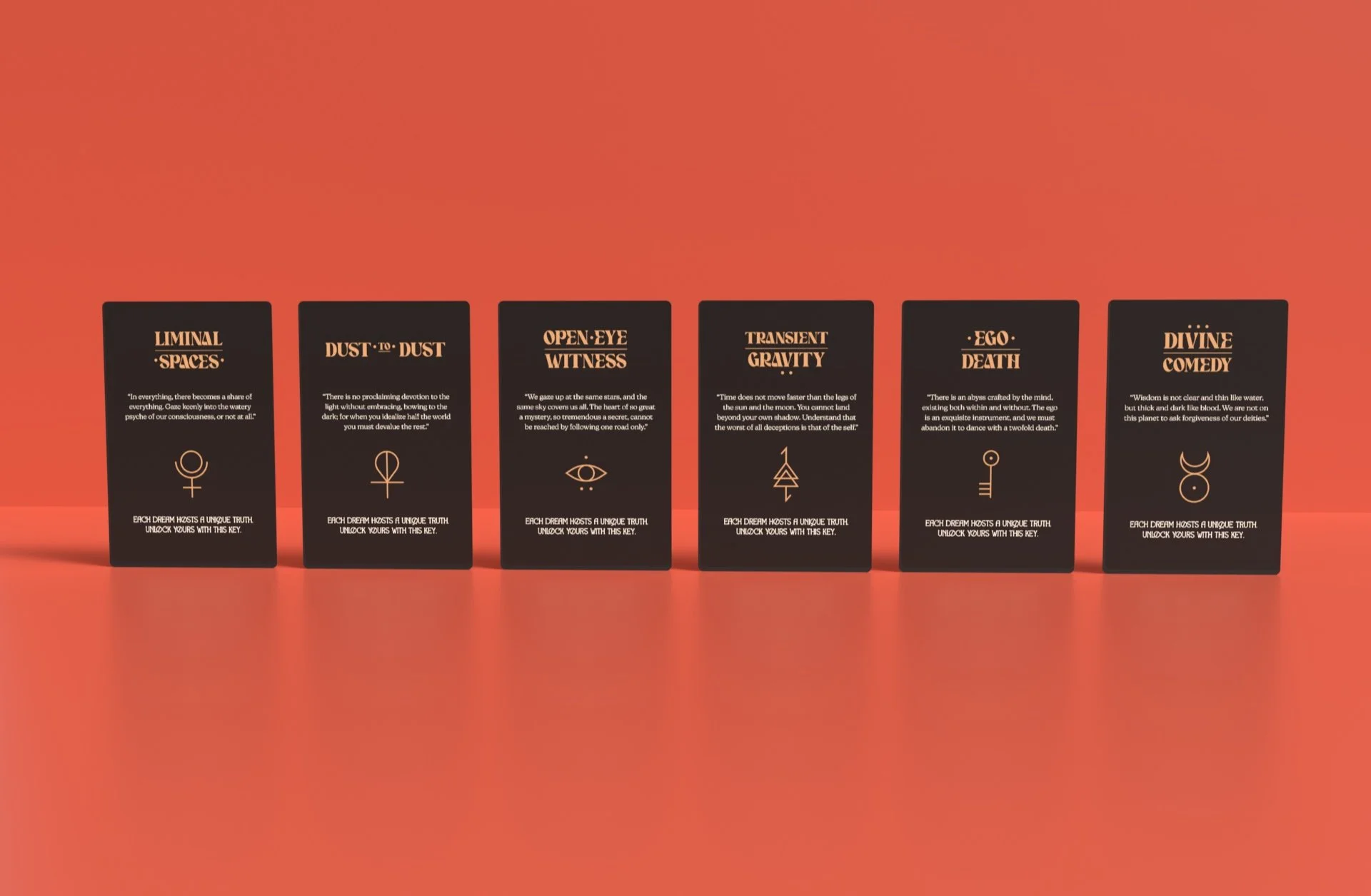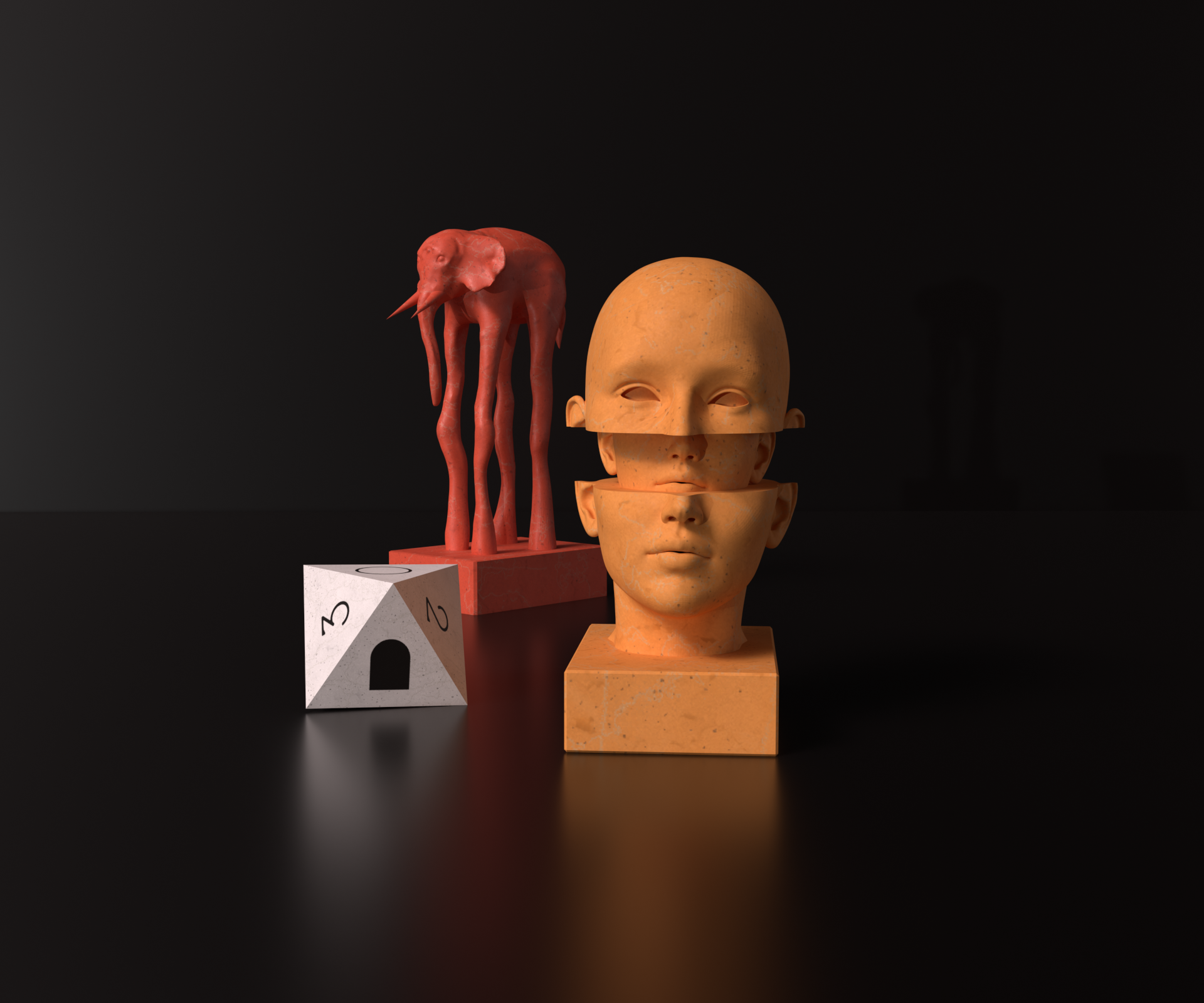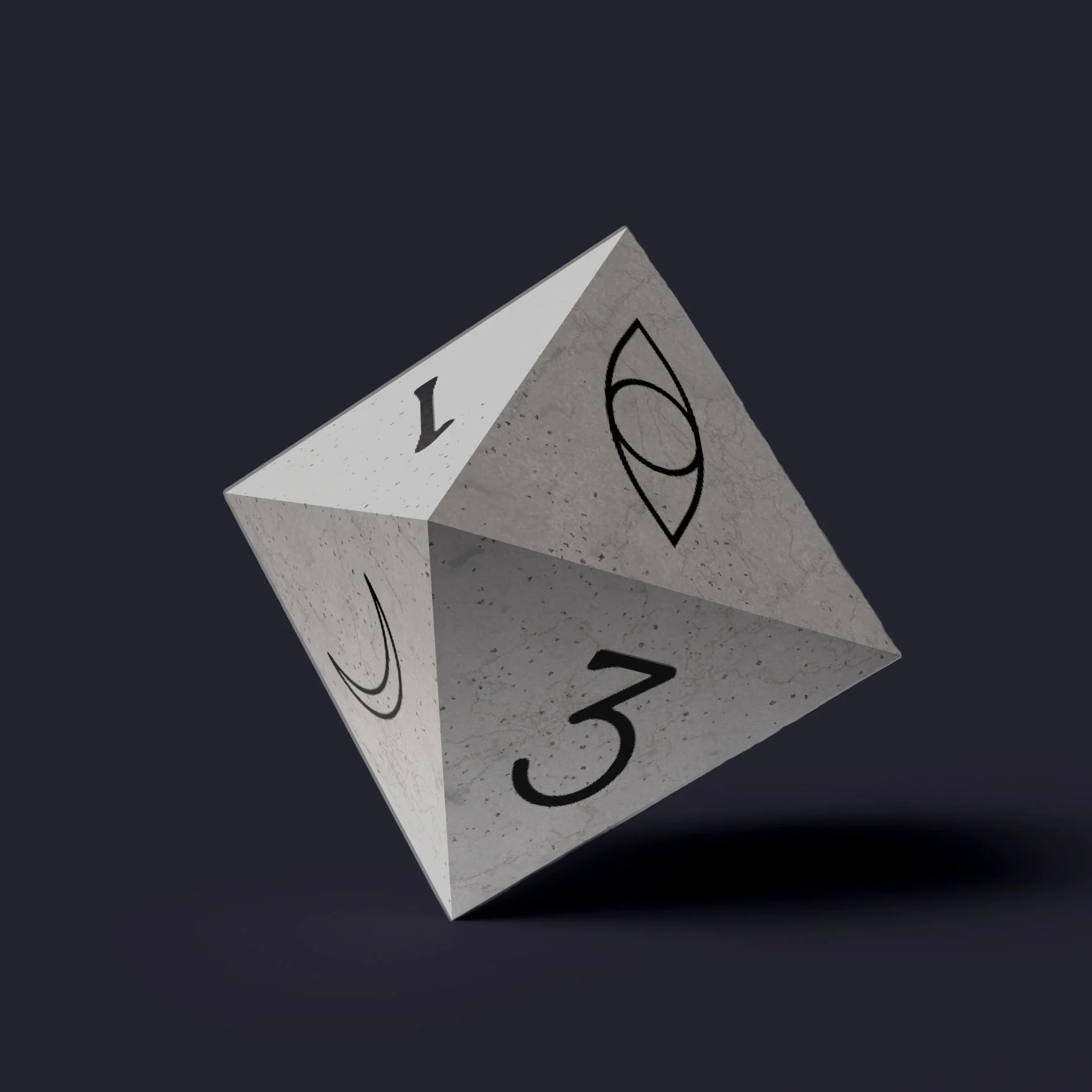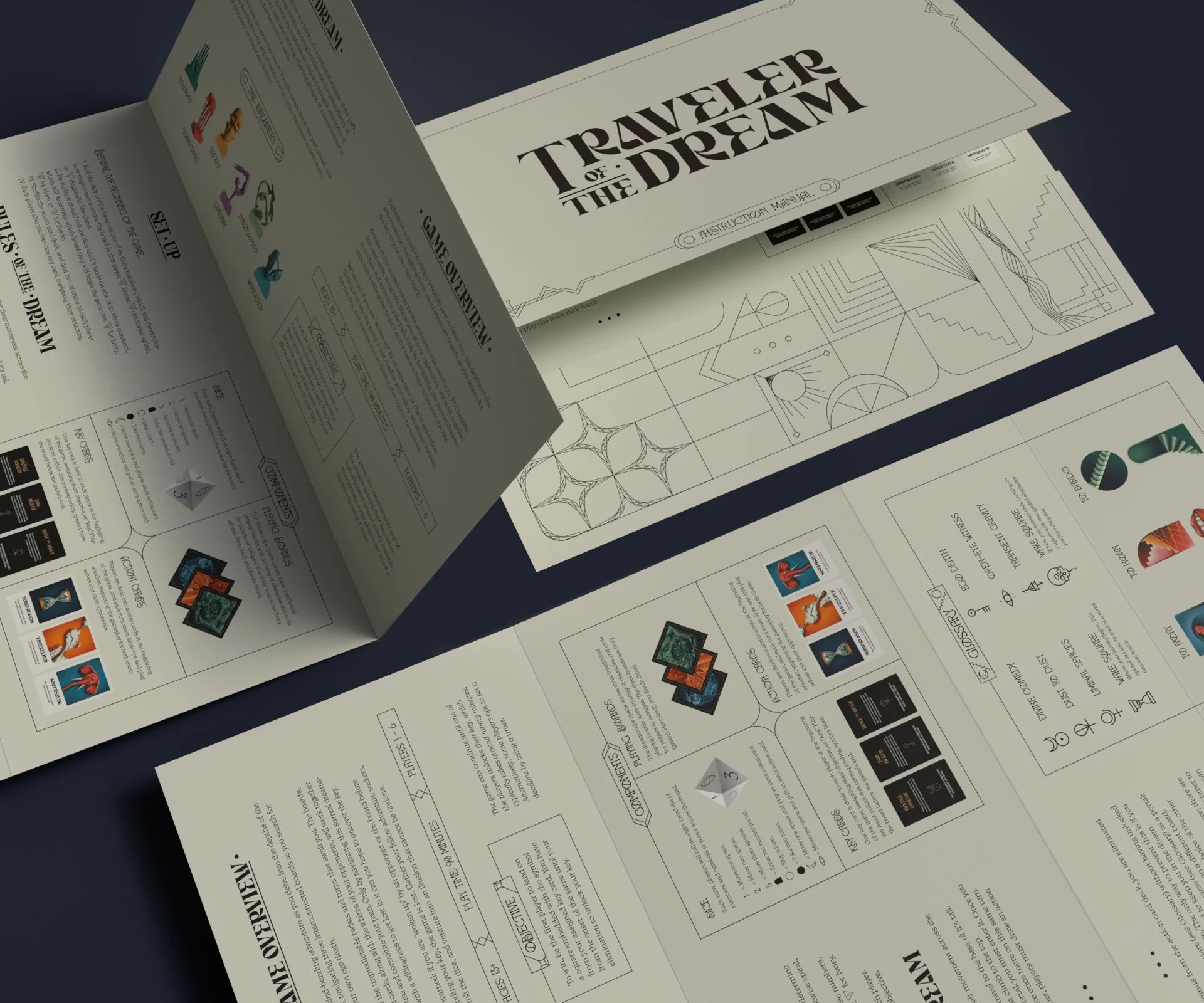INSTITUTION Tyler School of Art and Architecture
INSTRUCTOR Sean McCabe
SPRING 2023
Traveler of the Dream is an interpretation of the classic board game Snakes and Ladders, in which players must navigate a confusing landscape of dreams, nightmares, and surreal oddities, seeking to discover “ego death” on three interlinked, ever-changing playing boards - they must do so before they awaken from the dream, or their game is lost.
Each gameplay is an unpredictable experience - everything from the way players move their pieces across the boards, to the objective assigned to each player, is determined at random at the onset of the game. Each turn, players are confronted with twists and turns, crafted by the boards with their portals and various obstacles, the dice and playing cards, and finally, the whims of their opponents. Essentially, players embark on a race where strategy plays no role, and they must instead embrace the idea of getting lost in order to eventually find their way.
For my senior thesis project, I found myself instantly drawn to the idea of conceptualizing a heavily illustrative, experimental board game. Growing up, my siblings and I were pretty much always creating our own games or adapting and expanding the ones we already had. I wanted to tap into some of that creative freedom of childhood, and I felt that a project like this would allow me to be experimental without bounds, while still creating a design piece that challenged me to create a cohesive brand system for a very complex product.
Traveler of the Dream manifested as a means of merging several of my personal interests - the occult, mysticism, psychedelics, philosophy, etc - and these, in turn, influenced the research and copywriting process, development of a cohesive illustration style, and the finished board game package.
In the process of building a concept, I set out to create a product that was non-traditional and, hopefully, thought-provoking. Having selected the basic structure of Snakes and Ladders to distort and expand upon, ideas began to flow: What kinds of themes could a board game like this adhere to that would allow it to become something intricate, creative, and complicated?
My interests in psychedelic and surrealist art informed the logical direction of the game that began to take shape. I began to compile works from artists like MC Escher, Max Ernst, Salvador Dali, Leona Carrington, Jamie Zuverza, and Max Loeffler, inspired by their use of vivid, thought-provoking imagery that transcends any reason or bounds.
Amidst this process, it occurred to me that some kind of transcendental philosophy, relating to psychedelic breakthroughs, spiritual awakenings, and exploring the unconscious mind could translate into an interestingly abstract objective for a board game. I compiled recollections of psychedelic experiences and emotional breakthroughs, proverbs and the writings of philosophers throughout the ages, and ritual beliefs pertaining to elements, spells, and dream realms — this would eventually become a collection of verbiage and terminology to use for copywriting, and symbolism to inform the project’s visual tone.
From here, the idea of a more experiential game play, where exploring the intricacies of the board, as well as learning to embrace the journey rather than racing towards a strategic objective, evolved. And so, after research, I prioritized crafting an aesthetic and a rich, conceptual experience.
My vision for illustration centered around rich, densely colored artwork — I wanted to create a wide breadth of visuals that pertained to both the whimsical, off-kilter landscape the game takes place in, as well as the characters and obstacles players encounter throughout.
Illustration would be a heavily prominent characteristic of the game beyond the three playing boards. In order to add dimension and complexity to the game, I created a deck of “action” cards that would be played at each turn, influencing the gameplay in some way. I referenced tarot decks by naming them after some mystic element, and creating custom illustrations for the face of each of these cards.
Simultaneously, I outlined six different forms of “key” cards. These each represented some form of ego death or universal truth, which would align with each players objective within the game. The concepts for each of these cards were derived from my research, and I wrote brief proverbs or philosophical words of wisdom to accompany each one. Each symbol had roots in occult sigils and had a corresponding match on a square on each board, which is how players “unlock” their key.
For the backs of the cards, I created vector line-work reminiscent of Art Deco patterns, which could populate space in a way that contrasted and supported the bold richness of my illustration style. The design for the back of the key cards were meant to feel special, and incorporated symbols and mystic themes amid the geometric segments - this design would be translated to multiple packaging elements as a way to balance out the project’s visual tone.
When it came time to create packaging and the player pieces, I envisioned flushing out the game’s aesthetic by giving life to some of the characters of my 2D illustration. After time spent searching the internet for sculptural 3D models — which I didn’t feel suited the game’s atmosphere or cohesive visual style — I downloaded Blender, which as I learned, would allow me to sculpt custom models and modify some of the ones I had previously found.
I custom created six unique game pieces which would become the “Dreamers:” the Visionary, Clairvoyant, Seeker, Luminary, Philosopher, and Wanderer. Using this same process, I created an eight-sided octahedron dice, which contained both numbers and symbols that could send players to the nearest portal, cause them to skip a turn, play an extra action card, et cetera.
I’ve always been inspired by publications that unfold in unexpected ways, and I felt that creating something non-traditional and surprising as an instruction manual would suit Traveler of the Dream well. I created a four-panel foldout that would contain all necessary information in one short format, easily-digestible manual. This manual felt like a rewarding way to conclude my work with this project, as it finally pulled everything I had been working on into one place.
Spending a semester bringing this project to life was equally challenging and exciting. Having started off with a loose, abstract idea of something I wanted to see put into the world, and then being allowed the autonomy as a creator to expand on that idea and bring it to life in the way I saw fit, was an experience I have endless appreciation for. Thank you to everyone who encouraged and supported this project, and myself, along the way.






















